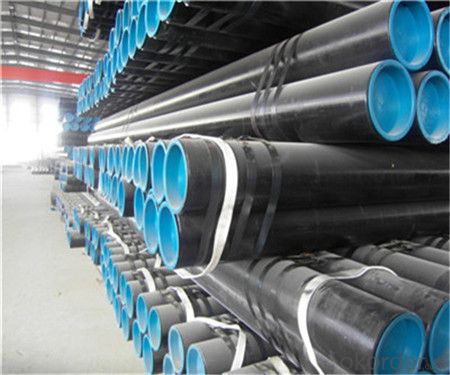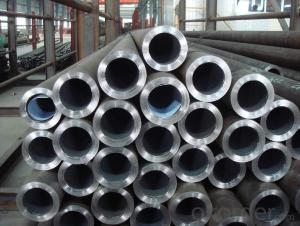ASTMA53/A106/API5L G.B Boiler Carbon Steel Pipe
- Loading Port:
- Tianjin
- Payment Terms:
- TT or LC
- Min Order Qty:
- 20 m.t.
- Supply Capability:
- 15000 m.t./month
OKorder Service Pledge
OKorder Financial Service
You Might Also Like
1、Structure of ASTMA53/A106/API5L G.B Boiler Carbon Steel Pipe:
Seamless pipe is formed by drawing a solid billet over a piercing rod to create the hollow shell. As the manufacturing process does not include any welding, seamless pipes are perceived to be stronger and more reliable. Historically seamless pipe was regarded as withstanding pressure better than other types, and was often more easily available than welded pipe.
2、Main Features of ASTMA53/A106/API5L G.B Boiler Carbon Steel Pipe:
• High manufacturing accuracy
• High strength
• Small inertia resistance
• Strong heat dissipation ability
• Good visual effect
• Reasonable price
3、ASTMA53/A106/API5L G.B Boiler Carbon Steel Pipe Specification:
Standard | GB, DIN, ASTM ASTM A106-2006, ASTM A53-2007 |
Grade | 10#-45#, 16Mn 10#, 20#, 45#, 16Mn |
Thickness | 8 - 33 mm |
Section Shape | Round |
Outer Diameter | 133 - 219 mm |
Place of Origin | Shandong, China (Mainland) |
Secondary Or Not | Non-secondary |
Application | Hydraulic Pipe |
Technique | Cold Drawn |
Certification | API |
Surface Treatment | factory state or painted black |
Special Pipe | API Pipe |
Alloy Or Not | Non-alloy |
Length | 5-12M |
Outer Diameter | 21.3-610mm |
Grade | 20#, 45#, Q345, API J55, API K55, API L80, API N80, API P110, A53B |
Standard | ASME, ASTM |
1) Material:20#(ASTM A 106/A53 GRB.API5LGRB,GB),45#,16Mn,10#.
2) Specification range:OD:21.3-610mm,WT:6-70mm,length:6-12m or according to the requirement of clients.
3) Excutive standards:GB,ASME API5L.ASTM A 106/A53,Despite of the above standards,we can also supply seamless steel pipe with standard of DIN,JIS,and so on,and also develop new products according to the requirements of our clients!
4) Surface:black lacquered,varnish coating or galvanized.
5) Ends:Beveled or square cut,plastic capped,painted.
6) Packing:bundles wrapped with strong steel strip,seaworthy packing.
4、Packaging & Delivery
Packaging Details: | seaworthy package,bundles wrapped with strong steel strip |
Delivery Detail: | 15-30days after received 30%TT |
5、FAQ of ASTMA53/A106/API5L G.B Boiler Carbon Steel Pipe:
①How is the quality of your products?
Our products are manufactured strictly according to national and internaional standard, and we take a test
on every pipe before delivered out. If you want see our quality certifications and all kinds of testing report, please just ask us for it.
Guaranteed: If products’ quality don’t accord to discription as we give or the promise before you place order, we promise 100% refund.
②How about price?
Yes, we are factory and be able to give you lowest price below market one, and we have a policy that “ for saving time and absolutely honest business attitude, we quote as lowest as possible for any customer, and discount can be given according to quantity”,if you like bargain and factory price is not low enough as you think, just don’t waste your time.Please trust the quotation we would give you, it is professional one.
③Why should you chose us?
Chose happens because of quality, then price, We can give you both.Additionally, we can also offer professional products inquiry, products knowledge train(for agents), smooth goods delivery, exellent customer solution proposals.Our service formula: good quality+good price+good service=customer’s trust
SGS test is available, customer inspection before shipping is welcome, third party inspection is no problem.
6.Images

- Q:How are steel pipes installed underground?
- Steel pipes are installed underground through a process called trenchless installation or open trench excavation. In trenchless installation, a drilling machine creates a tunnel underground, and the steel pipes are then inserted into the tunnel using a technique called pipe jacking or horizontal directional drilling. In open trench excavation, a trench is dug, and the steel pipes are laid in the trench before being covered with backfill material.
- Q:Can steel pipes be used for underground heat exchange systems?
- Underground heat exchange systems can utilize steel pipes, which are known for their durability and strength against the pressure and environmental conditions underground. Steel is resistant to corrosion and can withstand high temperatures, allowing for efficient heat transport. Moreover, steel pipes are readily accessible and cost-effective compared to other materials, which contributes to their widespread use in underground heat exchange systems. Nevertheless, it is crucial to appropriately insulate and safeguard the steel pipes to prevent heat loss and potential harm caused by external elements like moisture or soil displacement.
- Q:Can steel pipes be used for signposts or street lighting poles?
- Yes, steel pipes can be used for signposts or street lighting poles. Steel pipes are often chosen for their durability, strength, and resistance to harsh weather conditions, making them suitable for supporting signs or street lighting fixtures.
- Q:Are steel pipes resistant to UV radiation?
- Generally, steel pipes have resistance to UV radiation. UV radiation is known to cause damage to materials over time, resulting in fading, discoloration, and degradation. However, steel pipes usually have protective layers, such as paint or galvanization, that help shield them from UV radiation. These coatings act as a barrier, preventing direct exposure of the steel to UV rays and minimizing potential damage. Furthermore, steel's inherent properties, including strength and durability, make it less susceptible to the effects of UV radiation compared to materials like plastics or rubber. Nevertheless, it is important to note that prolonged exposure to intense UV radiation can still have some impact on steel pipes, such as slight discoloration or surface degradation. To ensure the continued performance and longevity of steel pipes in outdoor or UV-exposed environments, regular maintenance and inspection are recommended.
- Q:How are steel pipes used in the manufacturing of railways?
- Steel pipes are used in various ways in the manufacturing of railways. One of the primary uses of steel pipes in this context is for the construction of the railway track itself. Steel pipes are used to create the rail tracks that form the foundation of the railways. These pipes are typically welded together to form long, sturdy tracks that can withstand the weight and pressure of trains passing over them. Steel pipes are also used in the manufacturing of railway bridges and tunnels. These structures require strong and durable materials to ensure the safety and stability of the railway system. Steel pipes are often used in the construction of the support structures or piers that hold up the bridges. They are also used in the creation of tunnels, providing structural support and stability. Additionally, steel pipes are used in the manufacturing of various railway components and equipment. For example, steel pipes are used in the fabrication of railway signaling systems, which are responsible for controlling the movement of trains and ensuring safety. These pipes are often used to house and protect the electrical wiring and other components of the signaling systems. Furthermore, steel pipes are used in the manufacturing of railway carriages and locomotives. These pipes are used to create the framework and structure of the train, providing strength and stability. They are also used for various other purposes, such as the creation of air conditioning systems, brake systems, and fuel delivery systems within the train. Overall, steel pipes play a crucial role in the manufacturing of railways. They are used for the construction of rail tracks, bridges, tunnels, and various railway components and equipment. The strength and durability of steel make it an ideal material for ensuring the safety and efficiency of railway systems.
- Q:What are the different pipe fittings used with steel pipes?
- Some different pipe fittings used with steel pipes include elbows, tees, reducers, couplings, and flanges.
- Q:Seamless steel tube 89X4 meters, how heavy?
- The theoretical weight calculation formula of plain carbon steel and alloy steel seamless pipe:W=0.02466 (D-S) S, the density of steel fand 7.85kg/dmNote: weight per meter kg/m= (outer diameter wall thickness) * wall thickness *0.02466 units, mm: mmFor example, the seamless steel pipe with a diameter of 89*4 weight per meter:(89-4) *4*0.02466=8.384 kg / M.
- Q:How are steel pipes used in the construction of oil refineries?
- Steel pipes are used in the construction of oil refineries to transport various fluids and gases such as crude oil, petroleum products, and natural gas. These pipes are highly durable and resistant to corrosion, making them ideal for handling the harsh and corrosive substances found in oil refineries. Additionally, steel pipes are capable of withstanding high pressure and extreme temperatures, ensuring the safe and efficient transportation of fluids within the refinery.
- Q:How are steel pipes used in the construction of wastewater treatment plants?
- Steel pipes are commonly used in the construction of wastewater treatment plants for various purposes, such as transporting and distributing water, chemicals, and sludge within the facility. They are also used for constructing the main drainage systems, including sewer lines, stormwater drains, and effluent pipes, ensuring efficient and reliable flow of wastewater. Additionally, steel pipes are utilized for constructing the structural framework of treatment units, such as settling tanks, clarifiers, and aeration systems, providing stability and durability to withstand the harsh conditions of wastewater treatment processes.
- Q:What are the different end finishes available for steel pipes?
- Some of the different end finishes available for steel pipes include plain ends, beveled ends, threaded ends, grooved ends, and flanged ends.
1. Manufacturer Overview |
|
|---|---|
| Location | |
| Year Established | |
| Annual Output Value | |
| Main Markets | |
| Company Certifications | |
2. Manufacturer Certificates |
|
|---|---|
| a) Certification Name | |
| Range | |
| Reference | |
| Validity Period | |
3. Manufacturer Capability |
|
|---|---|
| a)Trade Capacity | |
| Nearest Port | |
| Export Percentage | |
| No.of Employees in Trade Department | |
| Language Spoken: | |
| b)Factory Information | |
| Factory Size: | |
| No. of Production Lines | |
| Contract Manufacturing | |
| Product Price Range | |
Send your message to us
ASTMA53/A106/API5L G.B Boiler Carbon Steel Pipe
- Loading Port:
- Tianjin
- Payment Terms:
- TT or LC
- Min Order Qty:
- 20 m.t.
- Supply Capability:
- 15000 m.t./month
OKorder Service Pledge
OKorder Financial Service
Similar products
New products
Hot products
Related keywords






























